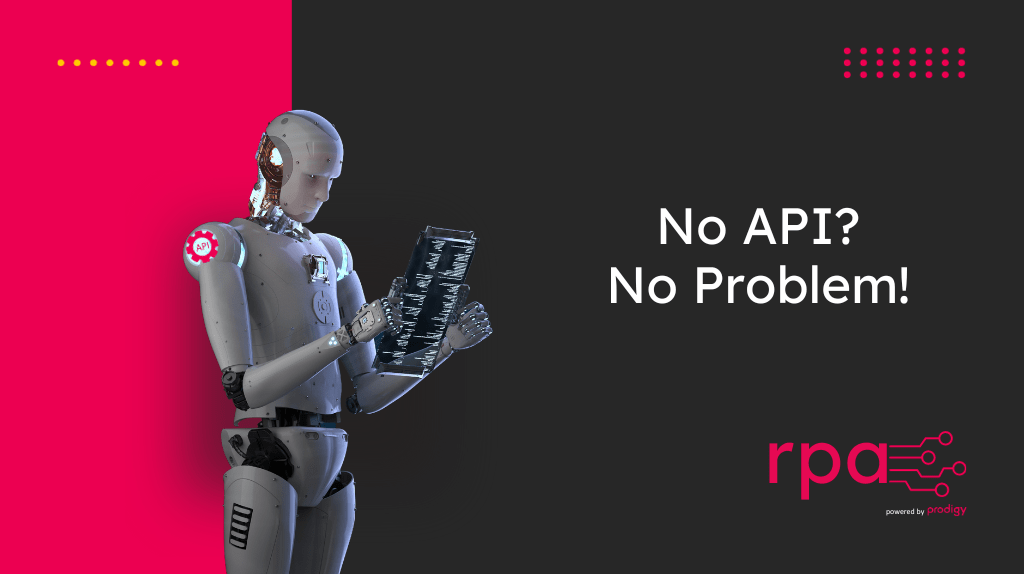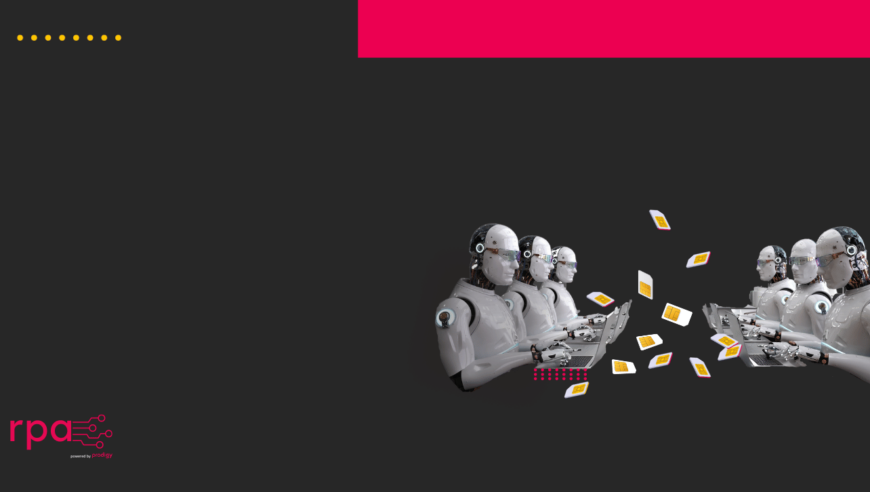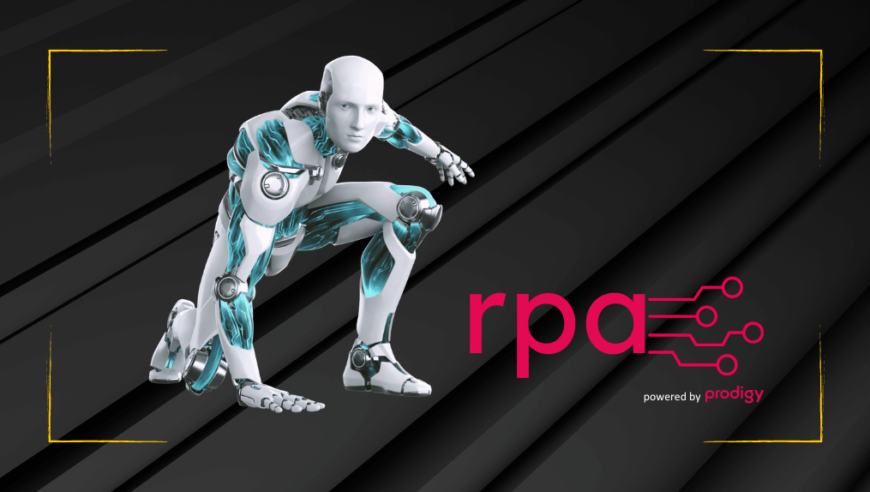
No API? No Problem!
Welcome to our Robots series! We’re exploring these smart machines and how they’re shaking things up in different industries. In this part, we’re talking about how the power of robots can be leveraged to access data silos where not API exists.
Legacy systems and the power of robots
Accessing data in legacy systems without API (Application Programming Interface) integration presents several challenges and complexities, making it a problem that businesses need to address. Find out more about API’s here.
One of the coolest qualities of robots is their ability to seamlessly interact with legacy systems. Unlike modern systems that support APIs for smooth interactions, legacy systems often lack this capability. That’s where robots step in to bridge the gap, just like a skilled conductor orchestrating a symphony.
These robots can mimic human actions with incredible precision. They can click, drag, and perform tasks just as a human operator would. So, if you’re grappling with a legacy system that conventional software can’t integrate with, robots step in as the ideal solution.
It’s almost like granting your legacy system a virtual lifeline. Even though it’s not a physical connection, robots can effectively manage it. Whether you’re a business owner looking to save time or someone grappling with integration challenges, robots offer a versatile solution.
But first, let’s take a look at the key issues and how they might be resolved.
Key issues with legacy systems lacking API integration
 DATA SILOS
DATA SILOS
Key Challenge
Legacy systems often operate in isolation, creating data silos. Without API integration, this data is trapped within these silos, limiting its usability.
How to address
For legacy systems with no API integration, RPA can solve this problem by emulating human interaction e.g. it can copy the data overnight from one system to another or to a different database.
 Manual Processes
Manual Processes
Key Challenge
Accessing data from legacy systems typically requires manual, labor-intensive efforts. This not only consumes time but is also prone to human errors.
How they can be addressed
As the organization evolves, internal processes change, necessitating system adaptations. However, legacy applications often pose challenges due to maintenance difficulties or outdated structures. RPA emerges as a solution by automating redundant steps that are no longer essential, freeing up employees to concentrate on more strategic and intelligent tasks.
 Inefficiency
Inefficiency
Key Challenge
Manual data retrieval and entry are inefficient processes, slowing down business operations and hindering agility.
How to address
Frequently, the need arises to transfer data between multiple systems, like Delivery systems and CRM, or E-Commerce sites and Delivery Providers. In legacy systems, this process involves time-consuming manual transfers or syncing without any intelligent automation. RPA provides a solution by automatically and regularly synchronizing data between systems, saving valuable employee time.
 Limited Scalability
Limited Scalability
Key Challenge
Legacy systems lack the flexibility to scale with business growth. They can become bottlenecks when expansion is needed.
How they can be addressed
As the organization evolves, internal processes undergo changes that necessitate system updates. However, legacy applications are often challenging to maintain and outdated. RPA comes to the rescue by automating unnecessary steps, eliminating the need for manual execution. This allows employees to concentrate on more intelligent tasks, enhancing overall efficiency.
 Security Concerns
Security Concerns
Key Challenge
Manual data transfer exposes data to security risks, as it can be mishandled, lost, or accessed by unauthorized individuals.
How to address
During the transition of data from one system to another, the risk of sensitive data breaches can escalate. RPA operates on the backend or on a server without the need for human interaction, ensuring data safety and mitigating the risk of breaches.
 Incompatibility
Incompatibility
Key Challenge
Legacy systems may use outdated data formats and structures that are incompatible with modern applications and analytics tools.
How they can be addressed
Owing to the lack of integrations in legacy applications, connecting with modern visualization tools like PowerBI becomes challenging. RPA effortlessly transfers data to modern databases or file structures, facilitating seamless utilization by advanced visualization tools.
The RPA Advantage
Think of traditional robots as those you might find assembling cars in a factory—they follow a set path and perform repetitive tasks. Now, imagine intelligent robots, more like digital assistants, capable of learning and adapting to new tasks without explicit programming. The key advantage of Robotic Process Automation (RPA) lies in deploying these intelligent robots to handle complex, rule-based tasks digitally. This means they can navigate various processes, make decisions based on data, and continuously evolve, making them highly efficient in automating a wide range of tasks without the need for extensive coding or human intervention.
Data Extraction & Transformation
Efficient extraction and transfer of data from documents or web pages, spanning areas like procurement, finance, and aviation, undergo a technical annotation and transformation process. Notably, this process can take up to two weeks for a single document. The significance of data transformation lies in its role in ensuring compatibility across diverse datasets. It integrates data sources, promotes interoperability, establishes standardization, enables improved analysis, optimizes data processing efficiency, and enhances collaboration in connected digital landscapes. Essentially, data transformation acts as a crucial bridge, allowing varied data sources to communicate effectively, unlocking the full potential of integrated and interoperable systems. Check out our RPA Team
Navigating Secure and Efficient Data Transfer
Data transfer can be a pain point, especially when reluctance to change systems is a concern, leaving valuable data locked in the existing system. The solution lies in dynamic and secure data export. Discussing and planning for encryption, compliance, and speed considerations is crucial for ensuring a robust data transfer process. In some cases, even with modern systems, certain data, such as financial transactions, may persist in the original system. The key is to manage both systems seamlessly through a unified interface, addressing security and compliance concerns while ensuring a speedy and comprehensive data transfer experience.
Consider the following example
Revolutionizing Inventory Management with RPA: Consider an inventory system in Dynamics and an ERP in Salesforce. While Dynamics diligently updates stock information, the lack of a direct API link to Salesforce creates a bottleneck. This is where RPA steps in. Daily, the RPA robot not only extracts real-time stock data from Dynamics but also facilitates seamless entry of items shipped to the ERP in Salesforce. This dynamic integration not only ensures accurate stock updates in Salesforce but also streamlines financial and diverse business processes, showcasing the transformative power of RPA in inventory management.
In conclusion, the challenges posed by legacy systems lacking API integration are significant and impact various facets of business operations. Data silos, manual processes, inefficiency, limited scalability, security concerns, incompatibility, high operational costs, compliance risks, delays in decision-making, and missed opportunities are all key issues that businesses encounter.
No API? No problem! The introduction of Robotic Process Automation (RPA) emerges as a transformative solution, revolutionizing the way tasks are handled digitally. RPA not only addresses these challenges of no APIs but also offers advantages such as efficiency, adaptability, and real-time decision-making capabilities. By seamlessly navigating data extraction, transformation, secure data transfer, and application in scenarios like inventory management, RPA can be a game-changer in enhancing operational efficiency and unleashing the full potential of integrated systems.
Ready to transform your legacy system with a tailored RPA solution?
Unlock the potential of your business operations with Prodigy’s RPA team. Specializing in finance, robotics, and Salesforce integration, our experts are dedicated to crafting cutting-edge solutions. If you’re aiming to boost productivity and streamline financial processes, we seamlessly integrate OCR and RPA technologies.
Leap into a future of efficiency and innovation – reach out to Prodigy’s RPA team today for a customized solution that meets your unique business needs. Elevate your operations with our expertise and propel your business into a new era of success.
Read more about our 6 Step RPA implementation process and How we train robots at Prodigy









